Earlier this year, Pattern Energy Group (PEGI +0.00%) unveiled a two-year strategy to put its 7.7%-yielding dividend back on solid ground. The main driver is a plan to grow its cash flow at a 10% compound annual rate over that time frame, which would help reduce its dividend payout ratio from a worrisome 99% last year to a more comfortable 80% by the end of 2020.
The company provided a bit more detail on how it intends to achieve that growth forecast during its recent first-quarter conference call. Here are the three catalysts that CEO Mike Garland believes will power the company's growth plan.

Image source: Getty Images.
1. The investment in Pattern Development is about to start paying dividends
Garland began his discussion on the company's three main growth drivers by stating:
We view our investment in Pattern Development as a clear differentiator for our business compared to our peers. We continue to believe that well-done developments offer the best risk-reward profile in the renewable value chain and one of the few ways to get more attractive returns than simply acquiring assets from third parties. Our total investment in Pattern Development now stands at $190 million with an additional $7 million invested in Q1.
Garland noted that Pattern Energy has invested $190 million into a development fund that's building new renewable energy assets. That investment, however, should start paying dividends soon. Garland went on to point out that the company "anticipates reporting gains on the sale of assets in 2019 and receiving initial distributions from Pattern Development in fiscal 2020." Pattern Energy has already sold one project out of that development portfolio and has several more in the pipeline. As those sales start generating cash, the company will see some of that windfall.
2. It has ways to improve the profitability of its existing assets
Next, Garland stated that "in addition to our growth prospects and development, we also continue to pursue opportunities to optimize and improve our existing assets." One opportunity it's currently pursuing is the repowering of its Gulf Wind project by replacing the existing turbines with new, more powerful ones. The company expects to invest $50 million in this project, which it should complete in the second quarter of next year. This investment should generate a high return, with Garland noting that "we expect to receive development-like returns from the investment of six to eight times CAFD [cash available for distribution] multiple versus the 10 times multiple at which we typically drop [acquire] an operating asset."
Because the company will earn such a high return on this repowering project, Pattern Energy will generate more incremental cash flow from this investment than if it spent that same $50 million to acquire an asset in a drop-down transaction with one of its development companies. As such, it will help boost its near-term growth rate.

Image source: Getty Images.
3. It has a large acquisition inventory
The third power source for Pattern Energy's growth engine is acquisitions. Garland pointed out that "we have a series of opportunities in 2019 and 2020 including Belle River, North Kent, Henvey Inlet, and Grady" that it could acquire. Both Belle River and North Kent are already operational, while the other two projects will start up later this year.
Overall, the company has the right of first offer to acquire renewable assets that have 1.3 gigawatts (GW) of capacity. That's a substantial figure considering that the company's current portfolio has 2.8 GW of capacity, which led Garland to comment that "this list provides visibility into our potential drop-downs and growth available to us." Meanwhile, Garland stated that they "expect [this inventory] to continue to grow with additions this year, which will significantly increase our opportunities." The only thing holding the company back from acquiring these assets is its ability to finance transactions, which is questionable, given its tight financial profile at the moment. That's why Pattern Energy is looking at a range of funding sources so that it has the cash to make the acquisitions needed to support its two-year growth plan.
All charged up
Pattern Energy believes that a combination of improvements to its existing operations, distributions from its development arm, and drop-down acquisitions will provide it with enough power to grow cash flow at a 10%-plus compound annual rate over at least the next two years. That rapidly expanding cash will enable the company to quickly improve its dividend payout ratio to a much more comfortable level, increasing its long-term sustainability. Meanwhile, with plenty of identified acquisition opportunities beyond what's needed to power its two-year plan, Pattern Energy should be able to grow cash flow -- and maybe even the dividend -- at a healthy rate after next year.






